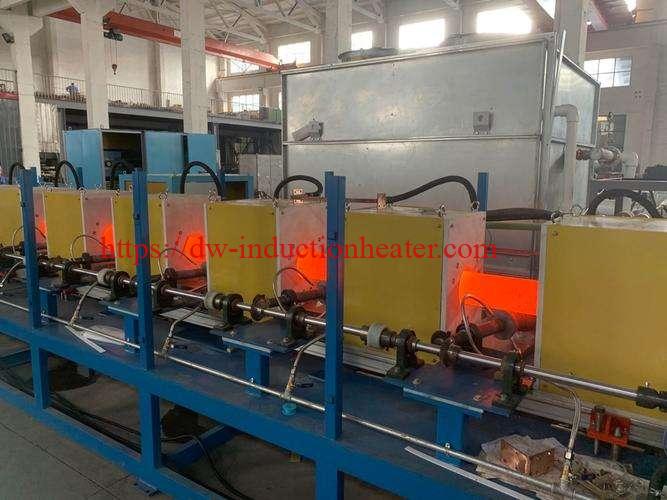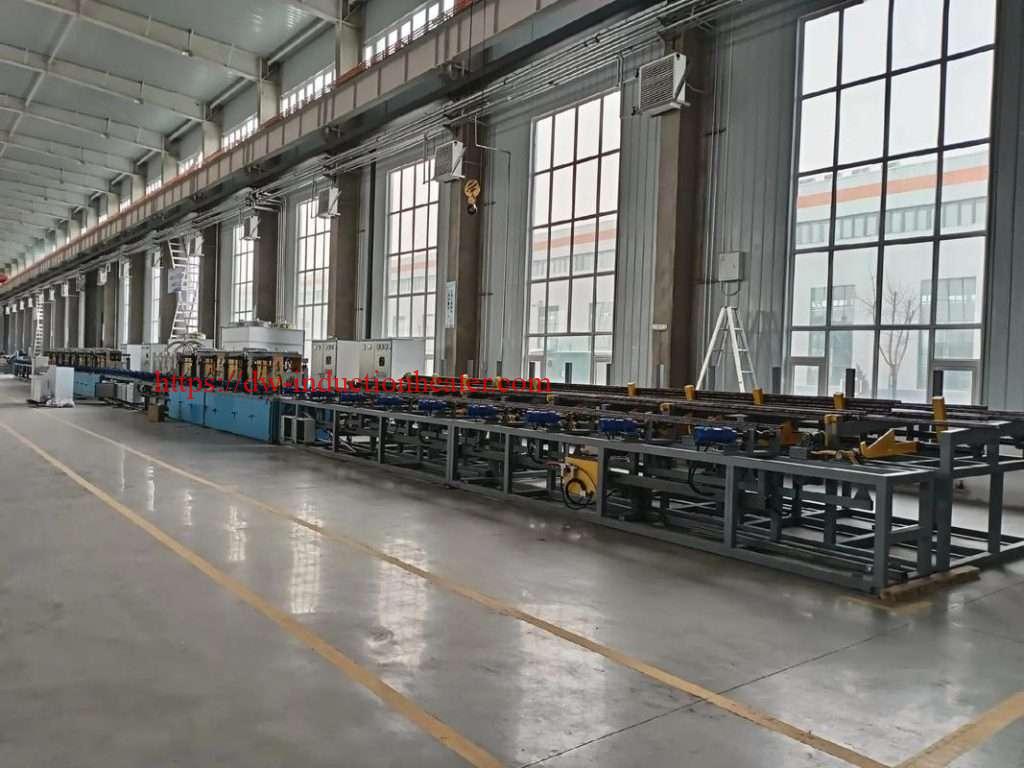Introduction to Induction Hardening and Tempering
What is Induction Hardening?
Induction hardening is a heat treatment process used to selectively harden the surface of steel components, such as rod wires, while maintaining a tough and ductile core. This process involves heating the surface of the steel using high-frequency alternating current (AC) and then rapidly quenching it to achieve a hard, wear-resistant surface.
What is Tempering?
Tempering is a heat treatment process that follows hardening. It involves reheating the hardened steel to a specific temperature below the critical point and then allowing it to cool slowly. Tempering improves the toughness, ductility, and impact resistance of the steel by relieving internal stresses and reducing brittleness.
Benefits of Induction Hardening and Tempering
Induction hardening and tempering offer several benefits for steel rod wires, including:
- Improved wear resistance and fatigue life
- Enhanced surface hardness while maintaining a ductile core
- Precise control over the hardened depth and hardness profile
- Faster processing times compared to conventional heat treatment methods
- Energy efficiency and localized heating, reducing overall costs
 The Steel Rod Wire Manufacturing Process
The Steel Rod Wire Manufacturing Process
Raw Materials
Steel rod wires are typically made from low-carbon or medium-carbon steel grades, such as AISI 1018, AISI 1045, or AISI 4140. These grades are chosen based on the desired mechanical properties and end-use application.
Wire Drawing
The wire drawing process involves pulling a solid steel rod through a series of dies with progressively smaller openings. This process elongates and reduces the cross-sectional area of the rod, resulting in the desired wire diameter and surface finish.
Heat Treatment
After the wire drawing process, steel rod wires undergo heat treatment to achieve the desired mechanical properties. This typically involves induction hardening and tempering processes.
Induction Hardening Process for Steel Rod Wires
Principles of Induction Hardening
Induction hardening utilizes the principles of electromagnetic induction to generate heat within the steel rod wire. An alternating current flows through an induction coil, creating a magnetic field that induces eddy currents in the steel wire. These eddy currents generate heat due to the electrical resistance of the steel, causing the surface to reach the austenitic temperature range (typically above 1600°F or 870°C).
 Induction Hardening Equipment
Induction Hardening Equipment
Induction Hardening Coils
Induction coils are the heart of the induction hardening process. They are designed to concentrate the magnetic field around the steel rod wire, ensuring efficient and localized heating. The coil design, including its shape, size, and number of turns, is optimized for the specific application.
Induction Heating Power Supplies
Power supplies provide the high-frequency alternating current necessary for induction heating. They can operate at frequencies ranging from a few kilohertz to several megahertz, depending on the required heating depth and production speed.
Quenching Systems
Quenching systems are used to rapidly cool the heated surface of the steel rod wire after induction heating. Common quenching media include water, polymer solutions, or forced air. The quenching rate is critical for achieving the desired hardness and microstructure.
 Induction Hardening Parameters
Induction Hardening Parameters
Frequency
The frequency of the alternating current determines the depth of heating and the heating rate. Higher frequencies result in shallower heating depths, while lower frequencies penetrate deeper into the material.
2. H4: Power
The power input controls the heating rate and temperature achieved during the induction hardening process. Precise control of the power is essential to ensure uniform heating and avoid overheating or underheating.
Time
The time duration of the induction heating cycle determines the depth of the hardened case and the overall heat input. Shorter heating times are typically used for thin sections, while longer times are required for thicker sections.
Tempering Process for Steel Rod Wires
Importance of Tempering
After induction hardening, steel rod wires are in a brittle state due to the formation of martensite, a hard but brittle microstructure. Tempering is essential to reduce the brittleness and improve the toughness and ductility of the steel while maintaining adequate hardness.
Tempering Methods
Oven Tempering
Oven tempering involves heating the hardened steel rod wires in a controlled atmosphere furnace at a specific temperature, typically between 300°F and 1200°F (150°C and 650°C), for a defined period. This process allows the martensite to transform into a more stable and ductile microstructure.
Induction Tempering
Induction tempering is a more recent and efficient method for tempering steel rod wires. It utilizes the same principles as induction hardening, but at lower temperatures and longer heating times. This process allows for precise control over the tempering temperature and can be integrated with the induction hardening process for improved productivity.
Tempering Parameters
Temperature
The tempering temperature is crucial in determining the final mechanical properties of the steel rod wire. Higher tempering temperatures generally result in lower hardness but improved ductility and impact resistance.
Time
The tempering time ensures that the desired microstructural transformation occurs uniformly throughout the hardened case. Longer tempering times may be required for thicker sections or when aiming for specific mechanical properties.
Quality Control and Testing
A. Hardness Testing
Hardness testing is a fundamental quality control measure for induction hardened and tempered steel rod wires. Common hardness testing methods include Rockwell, Vickers, and Brinell tests. These tests evaluate the hardness profile across the cross-section of the wire, ensuring that the desired hardness values are achieved.
B. Microstructure Analysis
Microstructure analysis involves examining the metallurgical structure of the steel rod wire using techniques such as optical microscopy or scanning electron microscopy (SEM). This analysis confirms the presence of the desired microstructural phases, such as tempered martensite, and identifies any potential defects or non-uniformities.
C. Mechanical Testing
Mechanical testing, including tensile, fatigue, and impact tests, is performed to evaluate the overall mechanical properties of the induction hardened and tempered steel rod wires. These tests ensure that the wires meet the specified strength, ductility, and toughness requirements for their intended applications.
Applications of Induction Hardened and Tempered Steel Rod Wires
 A. Automotive Industry
A. Automotive Industry
Induction hardened and tempered steel rod wires are widely used in the automotive industry for various components, such as suspension springs, valve springs, and transmission components. These wires offer high strength, wear resistance, and fatigue life, which are essential for reliable and long-lasting performance.
B. Construction Industry
In the construction industry, induction hardened and tempered steel rod wires are used for reinforcement in concrete structures, prestressed concrete applications, and wire ropes for cranes and elevators. The high strength and durability of these wires ensure the safety and longevity of construction projects.
C. Manufacturing Industry
The manufacturing industry utilizes induction hardened and tempered steel rod wires in various applications, such as machine tool components, conveyor belts, and industrial fasteners. These wires provide the necessary strength, wear resistance, and dimensional stability required in demanding manufacturing environments.
 Conclusion
Conclusion
A. Summary
Induction hardening and tempering are essential heat treatment processes for steel rod wires, providing a unique combination of surface hardness, wear resistance, and core toughness. By carefully controlling the induction hardening and tempering parameters, manufacturers can tailor the mechanical properties of steel rod wires to meet the specific requirements of various industries, including automotive, construction, and manufacturing.
B. Future Trends and Advancements
As technology continues to evolve, the induction hardening and tempering processes are expected to become more efficient, precise, and environmentally friendly. Advancements in power supply technology, coil design, and process automation will further enhance the quality and consistency of induction hardened and tempered steel rod wires. Additionally, ongoing research in metallurgy and materials science may lead to the development of new steel alloys and innovative heat treatment techniques, expanding the applications and performance capabilities of these wires.
 FAQs
FAQs
1. What is the difference between induction hardening and conventional hardening processes? Induction hardening is a more localized and efficient process compared to conventional hardening methods, such as furnace hardening or flame hardening. It allows for selective hardening of specific areas while maintaining a ductile core, and it offers faster processing times and better energy efficiency.
2. Can induction hardening be applied to other materials besides steel? While induction hardening is primarily used for steel components, it can also be applied to other ferromagnetic materials, such as cast iron and certain nickel-based alloys. However, the process parameters and requirements may vary depending on the material’s composition and properties.
3. How deep can the hardened case be achieved through induction hardening? The depth of the hardened case in induction hardening depends on several factors, including the frequency of the alternating current, the power input, and the heating time. Typically, hardened case depths range from 0.5 mm to 6 mm, but deeper cases can be achieved through specialized techniques or multiple heating cycles.
4. Is tempering always necessary after induction hardening? Yes, tempering is essential after induction hardening to reduce the brittleness of the hardened steel and improve its toughness and ductility. Without tempering, the hardened steel would be too brittle and prone to cracking or chipping under load or impact.
5. Can induction hardening and tempering be performed as a single integrated process? Yes, modern induction hardening systems often integrate the tempering process with the hardening process, allowing for a continuous and efficient heat treatment cycle. This integration helps to optimize production times and ensure consistent quality throughout the entire process.






